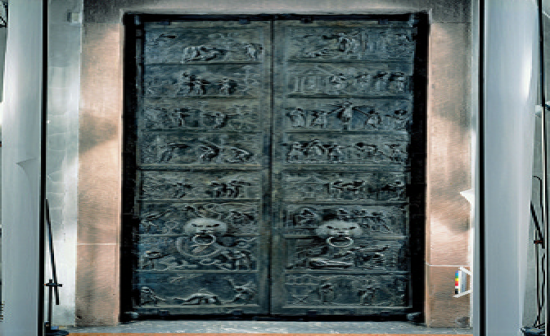
What is this image? |
|
Doors of Bishop Bernward, Hildesheim Cathedral, ca. 1015 CE
-bronze doors
man who paid for these was the bishop of killdeshine, after he had been the court chaplin and a tutor of Otto III
significant here that we identify art by the names of the arists, but often more important is the patron
in this case the patron is the bishop
thought up ideas for the doors, suggests there are different people who contribute to making a work of art, is a collaboration rather than one single work of genius
on exterior of a church attached to a monastary, commisioned these doors to suggest wealth of the place, very large, have to melt enough bronze to make the bed for these doors,
this is emulating ancient monuments, making things live again,
the monks in this monastary were corrupt, one rule that all monks have is celebacy, but a lot of these monks had kids
so bishop had these doors commisoned as a message for a need of greater virtue
the doors juxtapose a story from hebrew scriptures with a story from christian scriptures,
idea is that both jewish and christian history fit together and that history is not just a linear development, but a kind of a pattern, if you look from God's pov it would make a kind of a picture, |
| |
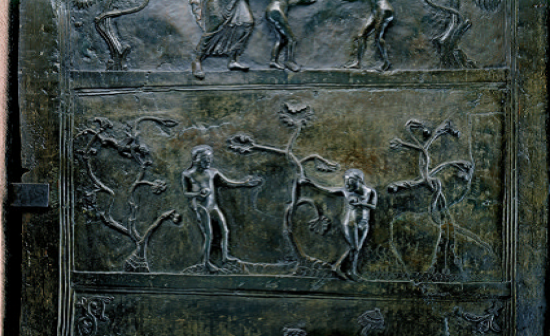
What is this image? |
|
The Temptation and Fall, Doors of Bishop Bernward, Hildesheim
Cathedral, ca. 1015 CE
- cast in bronze, classical idea, but the figures do not look classical
the story here is when the first man and first woman are in garden of eden, eve seems to be plucking one fruit and is holding another, shes holding it in front of her breast, the temptation is sexual, the fruit is eve's body?
instead of showing balance and confidence in the bodies, they are strong figures
rather than the perfected man made in God's image
|
| |
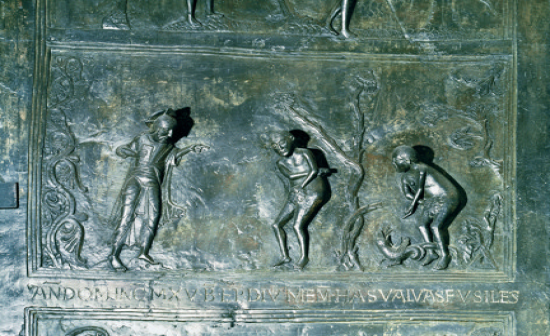
What is this image? |
|
Accusation and Judgment, Doors of Bishop Bernward, Hildesheim
Cathedral, ca. 1015 CE
- the one on left is not so much a classical figure, but with power and strong gesture,
moment adam and eve realized theyre naked, they show shame, this emotional storytelling doesn't necessarily come from greater realism, we don't have a naturalistic setting
instead from the schematic exaggerration that makes the forms seem more [pwerful it tells the story in a condensed way |
| |
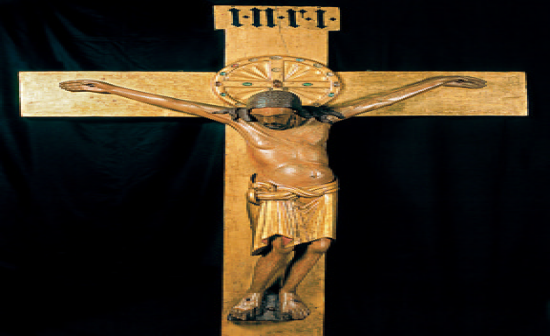
What is this image? |
|
Crucifix (known as the Gero Crucifix), ca. 970 CE,
- we begin to see an interest in showing the fragility of the human condition,
get a sense of a physical body that had been nailed to the cross, can get a sense of life from the depiction of jesus on the lindau gospel, but here he appears near death
this cross is over 6 feet tall
would look up and get an overwhelming vision that even God suffers this fate, some believe that because he was God, his suffering was much greater than man's |
| |

What is this image? |
|
Church of San Vincenç, Cardona, Spain, ca. 1029-1040 CE
(compound piers)
- Very stripped down, originally sculptures, stained glass, would look like a junk shop of religious offerings
- Stripped down due to modern tastes
- Theres very little architectural ornament here, a semi dome in the apt, use of stone throughout, there are no columns, instead we see compound piers supporting the arches and supporting the domes, have ribs or strips attached to them, so go up and help support the barrel vault, typical in medival architecture, we are looking at something the signifies differently in architecture |
| |

What is this image? |
|
Portal of the Church of Saint-Pierre, Moissac, 1115-1130 CE
- This is the door that faces out to the public, that you enter through, if you look closer at it the central half circle space is called the tympanum, the space between two doors is the trumeau
- The scene is the apocolapys in which jesus returns and he is enthroned, the figures here are of very different scales, get little sense of their bodies, God is this overwhelming prescene,
- Basically says you must repent |
| |

What is this image? |
|
Trumeau, Portal of Saint-Pierre, Moissac, 1115-1130 CE
- See stylized lions, as you walk through the door and if you turn to the side and look up you can see the picture of a prophet, you can see that theyre showing this to you and thought about those who would come to the church, would see this figure twisted looking down at them and it would be a terrifying thing |
| |
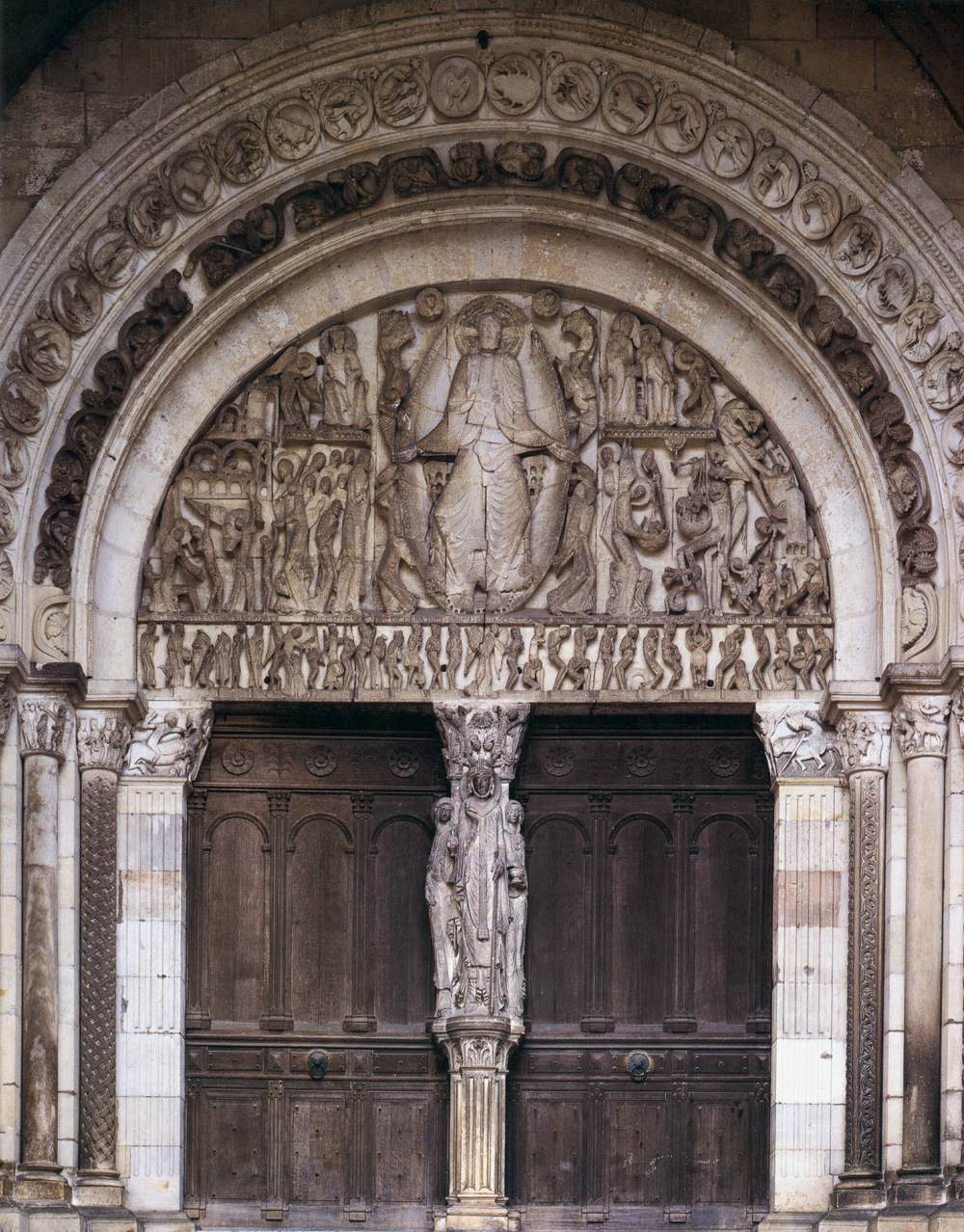
What is this image? |
|
Gislebertus, Last Judgment, West Portal, Saint-Lazare, Autun,
ca. 1120-1135 CE
- This is the artist, gislebertus, he signed it
- Can see the end of days, but here we see the last judgement, souls that are saved on the left, see the weighing of the souls on the right,
- Here different styles are used for different figures to make this explicit, God is huge, magnificent, etc.
- The others are small spindly,
- If you look at devil on the last judgement you can get a sense of the terror its meant to insite
- Here is the damned with enormous hands coming to grasp around his head, this illuminates the saldjaslk |
| |
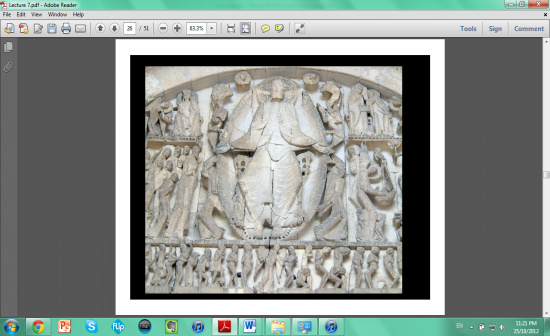
What is this image? |
|
Gislebertus, Last Judgment, West Portal, Saint-Lazare, Autun,
ca. 1120-1135 CE |
| |

What is this image? |
|
Cloister, Priory of Saint-Pierre, Moissac, ca. 1100 CE
- Here is the part where only the monks have access, inside the private part of the monastery, open in the center for light and air, place for reading and meditation
- These are places for reading, meditation, for monks, they’re ornately decorated, there are ornate columns, some have intertwined birds, have monsters, biblical stories,
- St Bernard of claivous, was frusterated with this kind of art, with the ornate decorations, why have these monsterous figures? Why have these for the monks? |
| |

What is this image? |
|
Nave, Abbey Church, Fontenay, 1139-47 CE
- This was never painted, had no stained glass, gold statues, built to be a kind of new restrained style that was supposed to focus your meditations and get back to “truer” Christianity |
| |

What is this image? |
|
Initial I, from Gregory the Great’s Moralia in Job, 1111 CE
- Don’t see any gold or blue, why have a picture at all? This I is made from monks cutting down a tree, working hard, at the same time, theres a potential for distraction, not totally focused on the text, |
| |
.jpg)
What is this image? |
|
Ambulatory, choir of the Royal Abbey Church of Saint Denis, France 1140-44
Abbott Suger
The ambulatory is the passageway that goes around the main apses in a church
Enormously important church politically and religiously in france at this time
Monks used this as their church, Benedictine monastery
Where the kings of france were buried
Also a shrine and contained the relics of sandonine, the patron saint and protector of france
We see religious functions and political functions inexplicably combined
Sought to gain control of a larger area (the French)
Reconstructed by abott sugar
The projecting absidioles (or nubs) the space has been opened up so it is not clear when you’re in a separate chapel, etc.
Separated by columns, light streams in through enormous stained glass windows, not blocked by any side walls, get a very new sense of light and openness as you walk through this choir
The abott runs the monestary, patron of this place, every detail in the construction of the project, he wrote about it and tells us how he had it ornamented in stained glass, sculptures, jewels, chalices made of gold encrusted with rich jewels, and describes how this should make us feel |
| |

What is this image? |
|
West façade of the Cathedral of Notre-Dame, Chartres, France, ca. 1145-1220 (left spire is 16th C.)
Period with enormous devotion to the virgin, the virgin was idolized, very little attention towards Christ
None of these churches are dedicated to jesus, but dedicated to his mother
Held the clothes she was thought to have worn when jesus was born,
Most Christians believe that mary rose physically to heaven,
Her clothes is a very important historic relic
Not symmetrical, built over the centuries
Symmetry is not as important here as it is in classical architecture, no sign of the orders, instead of columns that give us sense of proportion of the human body, we have emphasis on ascent, instead of articulating the structure and making it clear how it is held up, we have huge windows so that they look light and immaterial |
| |

What is this image? |
|
Jamb statues (Prophets, Kings, and Queens), west portal of Chartes, ca. 1145-50
Christian churches are oriented towards the east, direction of rising sun, west side is the principle entrance
This is the central door in that west façade
Statues of kings and queens who were thought to have prophesized the coming of Christ, politics is part of the mx here, important for religious devotion
Under royal patronage, royal lineage of kings and queens, suggests connection between the divine and rule on earth
Not classical, modern style, the forms have no attempt to show a moving body, statues are lined up against the columns and the feet don’t stand flat and have been given little platforms, this is about an eternal prescence, something stable |
| |

What is this image? |
|
Nave of the cathedral of Notre-Dame, Laon, France, ca. 1160-1210
These are gothic terms
Clerestory- up top level, lit with windows and is higher than the side aisles of the church, the light just flows down into that space
Nave- the central space that runs down the middle of a church
Triforium- third level, purely decorative, here you see three little arches
Gallery- second level, space in which you can walk, sometimes reserved for women
There are four levels of the side wall
Lowest is called nave arcade, pointed arches between these piers
Could compare the Santiago de compostela and laon
Only two levels in Santiago, upper level is a gallery, flooded with artificial light
Have much more complicated celings In the laon
Pointed arches vs the rounded arches, more of a reference to classical architecture in the Santiago
Pointed arches which create a sense of height, spanning greater spans |
| |

What is this image? |
|
Nave of the cathedral of Notre-Dame, Chartres, ca. 1194-1220
Greater emphasis on larger windows, make it seem miraculous that these buildings can soar above
Fire here, there was immediate effort to rebuild the church, the nave rebuilt in 26 years
Gives a sense of what a priority this was to rebuild this cathed |
| |

What is this image? |
|
Notre Dame de la Belle Verrière Chartres, ca. 1170 stained glass (ca. 14' high)
one large figure of the virgin mary
sitting in throne as queen of heaven, royal reds and blues covering her
fully frontal, makes her an iconic figure
difficult to achieve naturalism in stained glass
|
| |

What is this image? |
|
Villard de Honnecourt, Wheel of Fortune, ca. 1240
see an image of fortune, idea that you will go up on the wheel, can be the king on top and then fall and have bad luck later
difficulties we have in our lives
way they are drawn: done like little triangles, point is that just as the geometry of those vaults is complex, so to man is seen as a series of geometric shapes, schemetized, different from the classical ideals
|
| |

What is this image? |
|
Jamb figures, South transept ca. Chartres,
Saint Theodore
(left), ca. 1230
Saints Lawrence,
Clement,
and Stephen,
ca. 1215-20the ones on right were the ones constructed after the fire
three on right are more substantial, seem to stand and have weight, the projections overhead form canopies in which to stand, looking at st theodore on left (seperate one)
can see a difference in him (was made 10 years later)
theodore is not as stiff, has one hip up, one foot projecting, gothic sway or controposto, something more classical looking about him, seems to be in motion, much less of an iconic eternal figure, more classical and naturalistic
|
| |

What is this image? |
|
Nave and side aisle, cathedral of Notre-Dame Amiens, begun 1220
know the names of the architects, says something about the status of them in society in this period
this church is very tall, pushed the limits of height architecturally, created great soaring spaces that seemed miraculous
Robert de Lzarches, Thomas de Cormont, Renaud de Cormont
|
| |
13360092626)
What is this image? |
|
Cathedral of Notre-Dame, Reims (west façade) ca. 1225-90
see another kind of limit case, in terms of density of ornament and the way in which the facade is pierced and appears like lace
see not only a window in the center, see roses over the doors, timpana opened up into glass, tympanum is usually sculpted, seems to be only glass holding them up
see a use of micro architecture as there are towers atop towers, pinnacles encrusting every surface, not classical, aggressively not classical
radically modern, french
rejects all classical vocabulary
|
| |

What is this image? |
|
Visitation, from the jamb of the west portal of Reims cathedral, ca. 1230-65
statues on this facade look relatively classical
the two statues tell a story
this is the moment in which mary is pregnant with jesus and her cousin elizabeth is pregnant with st john the baptist, st john bows down to jesus (in their wombs),
drapery is pulled around their waists to suggest pregnant
elizabeth seems to be tilting down towards mary, which is a reversal of the status as it was common for older to get more respect
moment when gabriel tells mary she's pregnant
angel not controposto, see very little weight, see a curve running throught the whole body which creates a dance like rhythm, mysterious smile, gives certain emotion
see emotion, a story, something we can identify with,
little weight of bodies, has a courtly grace, elegantly pointed toes, abundant draperies, tall and slender and lovely
|
| |

What is this image? |
|
Annunciation, from the jamb of the west portal of Reims cathedral, ca. 1230-65
moment when gabriel tells mary she's pregnant
angel not controposto, see very little weight, see a curve running throught the whole body which creates a dance like rhythm, mysterious smile, gives certain emotion
see emotion, a story, something we can identify with,
little weight of bodies, has a courtly grace, elegantly pointed toes, abundant draperies, tall and slender and lovely
|
| |
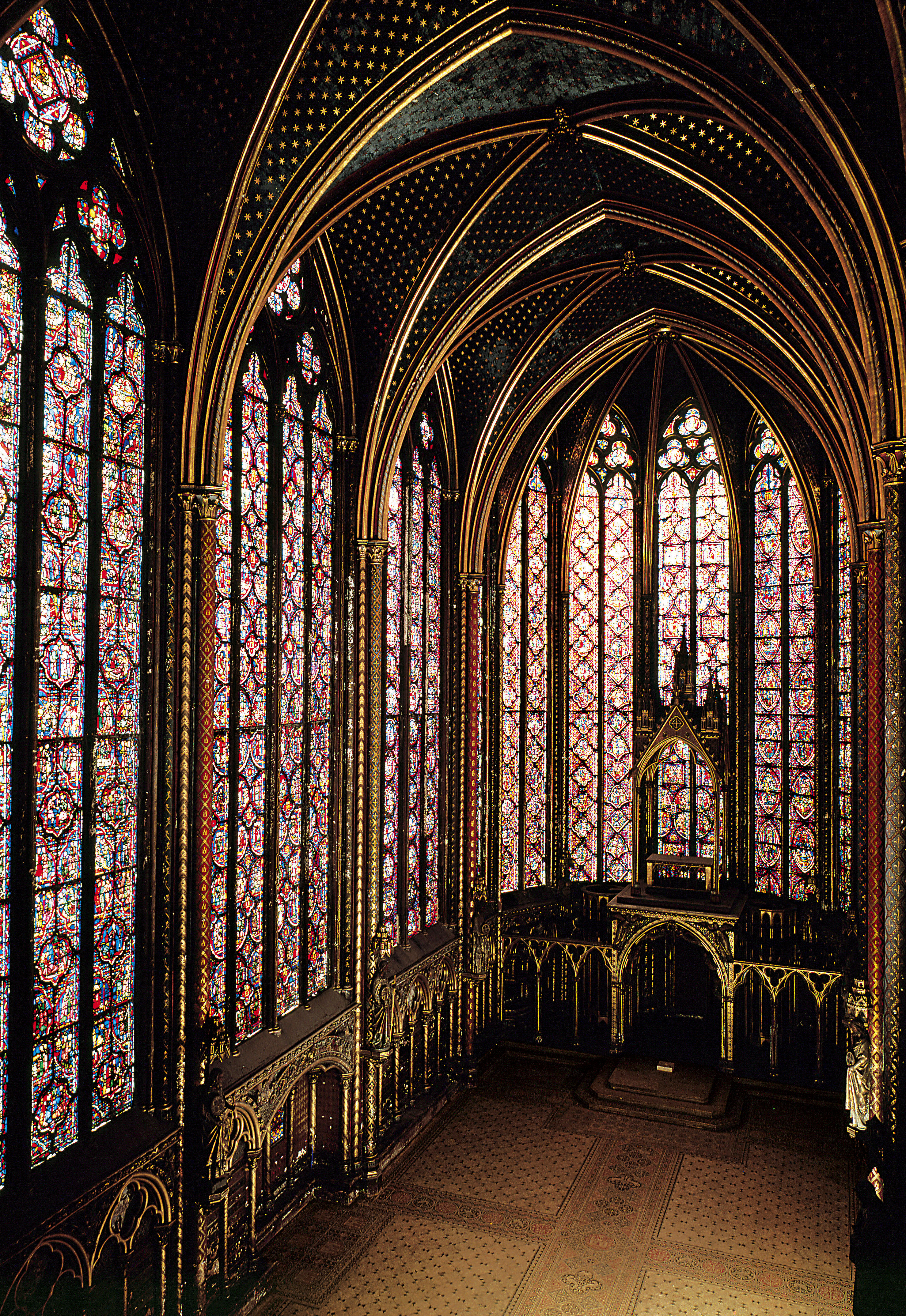
What is this image? |
|
Sainte-Chapelle, upper chapel Paris, ca. 1241-8 patron: King Louis IX
royal chapel
made for king lous the ninth
originally a part of the royal palace, palace chapel not a free standing church
made for a purpose, house an extrodinary relic, the crown of thorns, king louis the ninth can be seen in the stained glass taking back the crown of thorns,
brings this relic to paris, see chalice with crown on top
crown was kept in the throne like structure at the end
created so that light would flow through the object that held the crown
encased in gold because it is the most precious material, as if the whole chapel is a precious reliquary made large
|
| |

What is this image? |
|
Crucifixion and Deposition, from the Psalter of Blanche of Castile, ca. 1230
blanche was louis the ninth's mother
psalter is a book of psalms
see jesus on the cross, between mary and st john
nails are removed and being taken down
negative representation of the jewish religion on the right
asthetic is very similar to the thing we just saw in that it...
used the most expensive pigments, gold lead, lapis lapzule (only obtained from the mountains in afghanistan)
considered appropriate for the most terrible of moments bc it was thought to elevate these stories
|
| |

What is this image? |
|
The Betrayal of Christ and the Annunciation Hours of Jeanne d'Evreux, 1324-8 terms: Book of Hours, grisaille, marginalia
tiny book, 3.5 inches tall
delicately illuminated, is the ultimate luxery object
book of prayers that you would say at different hours of the day, for someone like a queen, etc.
receive the kind of sanctity that a monk would, could structure the day according to when you were praying
jeanne pousel is the artist
see two main scenes from the life of christ
see the annunciation, the angel is telling mary she is pregnant, have so much of a sense of space
mary is within her bedroom,
roof above her has a skylight open above so that a dove can fly down from heaven to make mary pregnant
it is very human, swaying pose is mary's pose, enormously elegant,
seems somewhat afraid
see a scene from the end of christ's life, the moment when one of his followers betrays jesus
moment when judias kisses jesus in order to show which one jesus is so the soldiers can come to arrest him
chaos of situation
s-curve is expressive of the violence of the figure and moment
violent, emotional, chaotic,
see peter cutting off an ear of one of the soldiers, jesus says he will let himself be arrested
don't see red blue gold here, very little colour, grissai (what its called)
reduction of colour to draw attention to the rendering of the figures
see two knights on goats jousting, a joke on chivalry
has sinister connotations, idea of a scape goat
goat is also a symbol of the ddevil
can see the queen reading the book of hours within the book of hours
angel on right seems to be holding up the scene,
the point is that you don't need to make that interpretation
|
| |

What is this image? |
|
Virgin of Jeanne d'Evreux 1339 gilded silver and enamel (height 27.5")
gives sense of central gradeful asthetic of gothic
came to ornanment sandiny,
have equisate gothic sway c-curve, drapery cascading all over her and creating elegance and gentilness
|
| |

What is this image? |
|
Interior, Santa Croce, Florence, begun ca. 1295 CE
Arnolfo di Cambio
Renaissance
tall pointed arches, long tall lancet windows, things that don't look like columns: gothic
this is a revival of classical antiquity, a rebirth of classical models is the renaissance
this architecture is more gothic
francisquen church
doesn't look like a gothic cathedral in that you have wide wooden trusses; makes it possible to have a bigger wider span, can accomodate the great crowds,
francisquen churches are built in the poorest places of towns
using the wood makes it appear a bit more humble
however, the building was by no means humble
it was covered in paint and gold, elaborately ornamented, idea was that if you were bringing in big crowds |
| |

What is this image? |
|
Interior of Upper Church, San Francesco, Assisi,
1228-1253 CE
can get a sense of the richness of the decoration, two churches stacked ontop of one another
theological slight of hand that allowed for these wealthy, francisquen churches (francisquen churches belong to the pope who lends them to the francisquens to use) brings to light the issue of art?
|
| |

What is this image? |
|
Nicola Pisano, pulpit, in the Baptistry, Pisa, 1259-60 CE
priest would give sermons in the pulpit
often in latin, or in italian
performing a utilitarian function (so they could see him and hear him), also elevating the priest and elevating the word of God
used to be covered in colour and ornament
can still see the colour on the
capitals vary slightly
there are a series of scenes on the rectangles aroung the side that were sculpted by nicola and depicted the life of jesus
these are the figures that were jewish men who were thought to have prophesized the coming of christ
is supported literally and figuratively by this story? |
| |

What is this image? |
|
Nicola Pisano, Fortitude (or Daniel), 1260
this is on the thing we just saw
lion cub on shoulder, see vicious one under his other hand
survived through this terrible exxperience of being stuck in a cave with a gorup of lions
mirroring view of history, just as jesus would suffer terrible on the cross and be reborn
figure of redemption
classical nude
daniel is seen as a hero, figure of salvation,
not ashamed, resolutely classical, controposto stance
way he is defined, forms of the body
look realistic but look very much like classical sculpture
this bodily beauty is somehting that radiates inner virtue and strength, not showing strength through armour, don't show salvation that he brings with looping clothes and that give a sense of wealth
that you show beauty through realistic shifting forms of the body, |
| |

What is this image? |
|
Giotto, Madonna Enthroned, ca. 1310 CE
later than the changes that happened in sculpture
makes sense that classicism would first emerge in sculpture as it was around??
showing moral weight and divinity
paradoxs built into the christian tradition, idea of relics, human becoming christ, etc.
|
| |

What is this image? |
|
Cimabue, Madonna Enthroned Giotto, Madonna
ca. 1280-1290 CE
around this period we see a new kind of literature
the three great writers of the italian renaissance looked back to the classical tradition and using classical models in their own writings, writings were in italian so people could understand them, told elevated tales of quests, also rude humour, love poetry, and rude humor
they were looking to the classical tradition for a way to express something about their own humanity and their own lives
both wrote about giotto
dante said that giottos fame eclipsed that of cimabue's, cim was considered to be a great painterat this time
can see the difference
giotto made these figures, get a sense of the bodies underneath the clothes, her enormous heaviness and figural presense, looks powerful because of her weight,
the baby also has weight, shown as a chubby baby, get a sense of the new humanity, physicallity of the divine, angels peering in the windows of the throne
saints who lived at all different times, not an earthly space but is given a physical reality
even the angels are heavy
illuminated from the front and the side
|
| |

What is this image? |
|
Giotto, Arena Chapel (Scrovegni Chapel), 1305-6
patron: Enrico Scrovegni
tempora paintings are made with pigments mixed with egg, on a frame prepared with gold leaf
fresco is different, pigment mixed with water, painted on plaster, forms crystals around the pigment, very tough and survives very well
originally a private family chapel, attached to the palace of enrico scrovegni
troubled history, father was a famously wealthy banker, charging interest for money
this was a sin, called usery
this new merchantile econmy that fueled the ren depended on banking, interest is a key part of banking, often jews were bankers, charging interest is not an issue for jews, get the stereotype of the jewish banker
however, so that christians wouldn't be left out of the profits, they were also bankers
dante put his father in hell, bc of all the interest he charged
had this chapel built as a way of giving the moeny back to the church and
also a luxerious thing to do as it shows his status and to show he is
|
| |

What is this image? |
|
Giotto, Christ entering Jerusalem, 1305-6
medium: fresco (some parts painted secco)
moment of solumn and triumph
before he is about to be arrested
shows jesus as humble as he rides in on a donkey
the people of jerusalem greeted him as if he were an emporer in
removing their cloaks on which jesus will ealk on as he enters into the city
couple of trees, mostly blue background
blue has not survived that well because you can't apply this kind of blue ot wet paster so overtime it will flake off
all the figures are given consistent lighting and space
side figures are slightly smaller tahn jesus, forms are broken off by belts
see the act of putting th cloak down,
jesus takes up the most volume, he is the heaviest, shown in profile, halo seems to take up space and overlap one another
jesus alone is singled out to give him a dignified thing
|
| |

What is this image? |
|
Giotto, Lamentation, 1305-6
when jesus is taken down from the cross and his followers gather around him to mourn
all react in different ways
some the grief is inwards, for others it looks like they're screaming
for those in the foreground, we see only their backs
grief in those figures are imagined,
the angels show us something about giottos power but also limitations
look like chunky babies that turninto wisps
he is a painter of mass and weight so it is evident that this is awkward as these are meant to be light
can see the heavy earthly form as we zoom in on mary
her arms encircle him
get a sense of the woman who is truley holding the body of her dead son
almost seems like she is about to kiss him, eloquent gap, space in between, makes you feel the horror and trajedy of the moment
|
| |

What is this image? |
|
Duccio, Madonna Enthroned with saints and angels,
Maestà Altarpiece, 1308-1311, tempera on panel
shows virgin and child, and bunch of saints,
the local sienses saints
both a religious monument and a civic monument
once this was completed and paraded into church, there was a celebration
looking at the details, don't have the same sense of mass, no huge figures with light flooding them, see the gold, wandering line of skirt, shows her as the queen of heaven, shows her as mary as she is ruling over an elaborat ecourt
|
| |

What is this image? |
|
Duccio, Christ Entering
Jerusalem, from the
back of the Maestà
altarpiece, 1308-1311
tempera
here is duccios eentering into jerusalem
big crowds, whole city
paving stones on which the donkey trots
it is less real in that it doesn't have light flooding it from one direction
more real in that it gives us more detail
|
| |

What is this image? |
|
Filippo Brunelleschi, Dome of Florence Cathedral,
1420-1436
new classicism of architecture
politics and religion are intertwined, so this is a cathedral, also a monument that came to define florence as a city and at this time as a republican city
taking this ancient tradition and making it come alive again
this was made in a time of political and financial stress, weathered terrible waves of the plague Black Death, florence did recover
period when different powers were competiting in the italian peninsula, at war a lot, particullarily with Milan
at this moment, the government sponsered the building of this great dome on top of the pre-existing florence cathedral
meant that the dome (initial church was gothic) was meant to be there in the original plans, just didn't have enough to do it
largest dome since classical antiquity, tallest
theres a double shell, when you walk up you go up between the double shell
made with an interlacing type of brickwork that helps hold the dome together
problem was centering and scaffolding, with a dome this size they realized they wouldn't be able to come up with enough wood for centering
developed a way of working their way up in incremints, built machines to hoist the materials up to the dome
a large part of the marvel of this architecture is the engineering that was used to do it
is it classical?
a dome is a classical form, but when you look at the pantheon from the outside you don't see the dome, brunelleschi has raised the dome and made it visible and made it more pointed in shape, gothic, a monument that you see from afar,
by varying the forms, he created a renaissance monument that embodied the hopes and ambitions of this new republic
reminds of the bapistery, he may nnot have realized he puit romanesque details on the cathedral
|
| |

What is this image? |
|
Filippo Brunelleschi, nave of S. Lorenzo, Florence, ca.
1421-1469
another church
built for a family that were increasingly powerful in this period and began to act more and more like princes
they were bankers, the metachi family
made them enormously powerful, had reasons to give their money to lavish commisions to churches to alleviate some sin for charging interest
different because they commisioned an entire basilica near their palace, this is the sort of thing the pope did, not normal for people
metachi were behind the scenes, if you had too much power you could be exiled from the city, were behind the scenes of the governemnt
corinthean columns, no fluting on shafts, can see this as a political statement, delicate balance in which the metachi were engagin in this period
COMPARED TO THE SANTA CROCE
rounded arches rather than pointed
corinthean columsn rather than faceted piers
clear glass that reflects off of these white surfaces, rather than
its much more about clarity, harmonous proportions, the way the elements fit together, creating a new space for this christian purpose
body of one of the metachi right in front of the altar under the church
central, foundational
|
| |

What is this image? |
|
Donatello, St. Mark (at Or San Michele), 1411-1413
politics and religion are intertwined
strange hybrid space in this period, its on a tall building that is right in the midst of the narrow city streets
this building was a grainery (stores of grain were kept here, to provide in times when crops were bad), and a sit where a miracle working madonna had been founf (so it was a church)
site for religious pilgramige
being able to provide bread in times of scarcity, could be essential, so the grainery is essential to keeping power in florence
they passed a law saying that each of the guilds that controlled a niche on the outside of the building, had to pay for an artist to make a statue for the place
guilds were professional organizations of the people who were higher up in teh working class who came together and made rules for society, rules for quality of standards of goods, came together and formed the government of florence
this one belonged to the linen drapers guild, had to do with the cloth trade, not the most rich guild, this is why they commissioned a marble statue rather than bronze
shows one of the writers of one of the gospels and one of the followers of jesus, st. mark
classical controposto, drapery reveals his body underneath
creating naturalistic cloth for the linen drapers guild, stands on a pillow
gives him a convincing sense of weight as the pillow yields under his foot and refers to this guild who manufactured pillows
holds his portion of the gospel
suggested something of republican philosophy
donotello resurected this classicism that will seem to exort you to a kind of republican idea?
|
| |
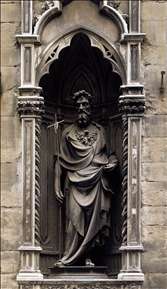
What is this image? |
|
Ghiberti, St. John the
Baptist, 1413-16
rival sculpture ghiberti, worked for the wool making guild, more expensive, in bronze, 10x as expensive as marble
this is st.john, grim prophet from the desert, the cloak on top of his camel hair cloak, doesn't look like a starving man in the desert
looks very light (gothic) almost like he's dancing
shows fabric that follows the laws of gravity, looks somewhat rough, this is donatellos power, not standing there through richness of materials but roughness that is expressive of the republican values
|
| |

What is this image? |
|
Masaccio, Madonna and Child enthroned with angels,
1426, tempera on panel
see the romantic myth of the artist
in the work of masaccio as well as in the personal image he publicly cultivated
panel of a much larger alter piece
angels around the throne that mary sits in
mary seems to take up space and grab the baby, chunky baby, the way the light bathes him, see him cheek moving around
done through a number of new techniques
linear perspective, a mathematical system for conveying projection in space, makes the throne look as if its real, assumes that the viewer is stationary and has one flat eye, this sophisticated geometry is something that the ancients didn't have its a radical innovation, can make space seem to appear before you
also the use of light, consistent light bathes forms from one direction, there are now cast shadows, ibn giotto we didn't see htis
here we see cast shadows, we see the madonnas head casting a shadow on this side of the throne
suggests some darkness, techniques add both to the realism and express religious meanings
seems three dimensional in a new way
at the same time, she is above us and we are below looking up, makes us feel as if the madonna is real and human and puts us in our rightful place
the light is also a technical innovation and expressive, suggests divinity, see the way in which he's eating something, the grapes refer to the fact that he will die later and the wine is made of grapes, wine becomes the blood of christ
by eating the grapes he is embracing this trajic destiny
massive strong stoic woman, she knew she was the last of the great prophetesses and knew what would happen to her son
long cast shadows suggests this dark fate
|
| |

What is this image? |
|
Masaccio, the Holy Trinity with the Virgin, St. John the
Evangelist, and two donors, fresco, ca. 1425
another by masaccio
shows linear perspective
had three aspects God the father the son and the holy spirit
God the father behind God the son
below him you see him being crucified, see mary and john
see the holy spirit as a dove
we don't see where jesus was crucified, possibly designed by brunalesscy himself (close to his architecture)
makes it look like there is a chapel in which these figures are placed
putting in this setting gives a new sense of terrigying logic, the way in which everything fits together, required the crucifiction,
there is a painting of a skeleton on the bottom of tomb that
make it clear that the patrons (on outside) show that there is a distinction between different classes? they have to stay outside, not allowed to be that close to jesus
the laws of perspective that uses this here are already broken as they are used selectively and meaningfully
|
| |

What is this image? |
|
Masaccio, Tribute Money, ca. 1425, fresco
shows how politics and religion are intertwined
jesus standing in the middle with his followers were stopped by a tax collector,
he asks jesus to pay a toll
directly applicable because at this time when at war with milan, they needed more moeny, they devised a payment plan??? the idea was that it says were desperate were at war,
reflected in the painting style, peter and the apostles, suggesting the moral seriousness and weight of the situation
cast shadows create an almost checkerboard floor |
| |

What is this image? |
|
Masaccio,
Expulsion,
fresco
ca. 1425
show adam and eve
here the physical weight doesn't suggest rectitude and righteousness but dispair
fallen pathetic
wants to suggest how the new naturalism is expressive and here particularly
they are mortal, the beginning of our universe
makes sense that showing forms that are heavy and naturalistic, that we should be able to identify with the first frajility of humanity
masaccio is one of the first painters to use cast shadows
their legs cast long shadows onto the barren ground outside paradise
entered into the cold hard day of reality
heavy bodies
eve understands the trajedy through her body, covers up,
adam has intellectual shame, covers his face, doesn't cover his body, knows thats not whats important, his shoulder arches and gives us a physical sense of the weight of human sin
is a fresco
painted on wet plaster
the way in which its painted in thick brush strokes is characteristic of fresco and adds to the heaviness
|
| |
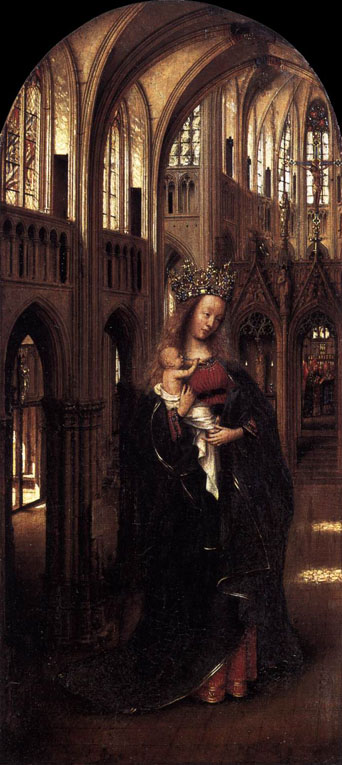
What is this image? |
|
Jan Van Eyck, The Madonna
in a Church, ca. 1425-30
oil on panel
oil was used as a painting medium in the 10th century, but people thought that jan van eyck was the creator
no one had developed such a sophisticated technique as jan van eyck did, no one had done this before
can apply oil paint in translucent layers, takes a long time to dry, can work wet on wet, which you cannot do on tempra or fresco and let the colours bleed into one another
Van eyck would have a bright underlayer and then paint over it in a series of glazes
layered on top of one another so that when you look at a painting, they literally seem to glow, because light travels through the glazes and reflects back to you, gives an richness and deepness, have deeper darks
over a foot tall, not an altar piece, small devotional work, most of his work is very small
here he uses oil to give us a different setting for the virgin, didn't copy an existing church, instead he created a historically accurate depiction of a gothic interior, accurate in light as well
she is way too big for the cathedral, departs from naturalism by making her this huge scale aka great importance, creates through the visual means a metaphor, the idea that the virgin is the church, by making her large her spiritual status is enappted
another departure from naturalism, much more subtle
the apse of a church is in the east historically it is, you can see light pooling on the floor but this is the north side, so its not physically possible, so in a subtle way this is the sort of thing you would realize, this is a supernatural light,
there are inscriptions on her robe and around the painting
|
| |

What is this image? |
|
Jan and Hubert van Eyck,
Ghent Altarpiece (closed),
1432, oil on panel
enormous complex altar piece, painted by Jan and Hubert
has hinged panels that close and open, this is the closed everyday altar piece, on special occassions it is opened
see the man who commisioned it and his wife, they're in red, both ugly, wart on chin, theres a kind of austerity about showing yourself as you are
the two saints are painted as if they're statues
see the scene of teh anunciation above this
see virgin mary on the right reveiving the news, see how they look as if they've been drained of colour, very restrained, pointed this out so that we understand the richness of the way in which the interior was
|
| |

What is this image? |
|
Jan and Hubert van Eyck, Ghent Altarpiece, open,
1432, oil on panel
very rich in colour, jewels and gold, a complex object
God in center, both God the Father and jesus, looking eternally youthful mary, adam and eve on the sides
see great crowds of worshippers below
adoration of the lamb is the bottom scene, lamb symbolizes jesus, with oil the brillant and complex landscape, get a panoramic view that is both microscopic and something else
over 30 varieties of actual floral in the lamb scene, all blooming at once, this is jan van eyck's kind of miracle, does not show explosive dramatic scenes, muscular motion, shows the miraculous nature of the natural creation almost frozen by the light
DETAILS OF MARY
conveys a new vision of saints and the divine (the oil paint)
uses oil to give her hair not hairs
her mouth is open, can see teeth, looks as if she's speaking
oil elevates her at the same time as it makes her human, with her ornate crown with roses lilies and pearls all done through the oil glazes that give us rich textures and brilliant effects
DETAILS OF CHRIST
God is also shown as vividly real, the way the ear falls into shadow and comes into light, rigid in pose and covered in thick ornamental jewels
Van Eyck's realism didn't only apply to ornamental jewels and flowers but also to the brutal realities of the human condition
|
| |

What is this image? |
|
ADAM AND EVE
makes the whole altar piece a kind of history of man, right from the creation to the fall to the last judgement
until the end of days
we don't see one moment, we see all of human history
here you see Adam
linear perspective is not correct according to the italian pov, there is a much more realistic pov for adam and eve, seems much more grounded, hands are darker and arms are paler, not exactly classical looking nudes, eve is not pregnant, different ideal of feminine beauty, she is a paragon of lovliness
gives us a different vision of what it means to be human, the way oil shows flesh and hair makes these figures look terribly naked
see that for the first time here
COMPARED TO OTHER ADAM AND EVE
not that one is more real than the other, is that they use different means to show the story and flesh and
|
| |

What is this image? |
|
Jan van Eyck, The Arnolfini Portrait, 1434, oil on panel
this is a painting he made for an italian couple who were living in the netherlands as merchants
here the couple is shown in their bedroom (not necessarily the private spaces as we think of them), people shared beds, bedroom was often one of the most decorated places in the house therefore it makes sense that the bedroom is shown
the linear perspective is not consistent, the lines don't all add up at one vanishing point, there were different means for naturalism here
we may be seeing the marriage of the arnolfini, taking of the hands the man raising his hand, the whole idea of weddings occuring in churches came much later, in order to have a wedding you need to have two people swear to marry each other
she is not pregnant, just emphasizin the roundness of her belly because she is feminine, and surely will be a good child bearer in the future
when is a dog just a dog?
because its so naturalistic, we wonder if its just a dog
see giovannis shoes, at a note of rich realism, we can see the crinkles of the leather, the fact that he has removed his shoes is an anciet idea of sacred grounds
the chandelier has one lit candle, suggests that it is referring to the divine ceremony (it is daytime why do you need a candle?)
see the script on wall that says jan van eyck was here, may mean that he was there to witness the wedding, may be a documentation of sorts,
DETAIL OF THE SIGNATURE AND CONVEX MIRROR
figure in blue is jan van eyck, only see him in the playful distorted view of the mirror
in other words
as spectacular and convincing and naturalistic as this painting is, jan van eyck is telling us that this is artistry, beaking the illusion of the naturalism and showing you his artistry in a very artful way
|
| |

What is this image? |
|
Rogier van der Weyden, Descent from the Cross, oil on
panel, ca. 1435
in this painting we see the moment (central panel of the altar piece) after jesus has died on the cross, dead body is held and displayed in front of us by his followers and mother mary
she is the one who suffers most because she is the one whoh feels closest to him
turned very pale, her body mimics his, as if she is feeling what he is feeling, almost dying as he dies, get an exemplar of mourning, deeply emotional, 6/9 mourners have tears rolling down their cheeks,
where are they? not a flat gold ground, painted illusionistcally as if they are in a box
the box adds to the inescapibility of the scene, if mary were to stand up she'd hit her head, we can't get lost in looking at landscapes in the distance, we are left with confronting the trajedy right in front of us,
shwoing his artistry in this work, makes it look like sculptures coming alive, hihgly emotional
naturalism does not clarify interpretation, does not clarify meaning or when things are just htings
tears, etc. depart from naturalism. in order to make the physical meaningful,
|
| |
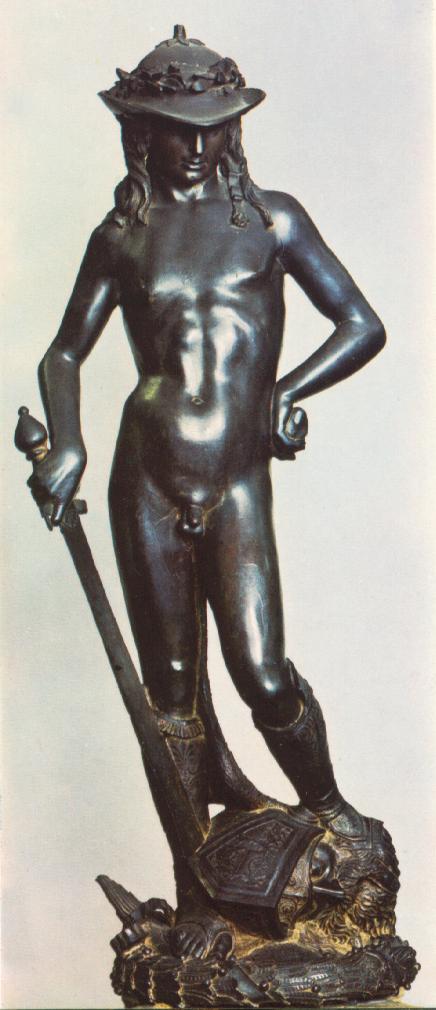
What is this image? |
|
Donatello, David, bronze,
1420s-60s
patron: Cosimo de’ Medici
politics changed in this time, art changed in this time
Medici got too powerful, exiled from the city, then under political pressure they used the medici as their bankers and were recalled to the city, were more open in their display of power
in this atmosphere, donatello made this statue for cosimo to go inside their private palace
full scale, bronze statue for a private individual in his private palace, a political statement, the medici are somewhat like kings?
innovative in many respects, the first free standing full scale nude since classical antiquity; declaration of classicism, kind of claiming a whole era for the medici?
subject is david who faces goliath
hits him with slingshot and then kills him with goliath's sword; this is his moment of triumph, standing on head of goliath, sword is too big bc its not his
he's vulnerable bc he's shown without clothes,
it doesn't look on first sight, what we would expect of a masculine hero, looks quite feminine (due to our modern prejudices)
this slung hip gesture is a specifically feminine in modern culture, in the renaissance it was agressively masculine, women don't have parts of their body that project, womens arms stay down, shoulders are shown as severely sloped so it doesn't seem like they have bones, this gesture is something only men do
long hair on men is exclusively masculine in this time
something androgenous in this smooth body; most beautiful men were thought to be a bit feminine, he is made exquisitely beautiful
eroticism is heightened (seen in back), the feather from goliath's helmet goes up the inner thigh of david to his groin
seems to be an erotic relationship between the head of goliath and david
the purpose suggests something of the sophisticated courtly culture, david means beloved, part of the complex culture of the period, whole idea that you slay your beloved and the eroticism and the violence make it a part of this culture
|
| |

What is this image? |
|
Donatello, Mary Magdalene, ca. 1430-50
polychrome and gold on wood
patron saint of prostitutes, see next slide to see how she was usually portrayed
she was forgiven because she loved so much,
donatello sees her as an old prostitute, the female equivalent of the stark st john the baptist after he's been in the desert starving
he sees her differently than others did
|
| |
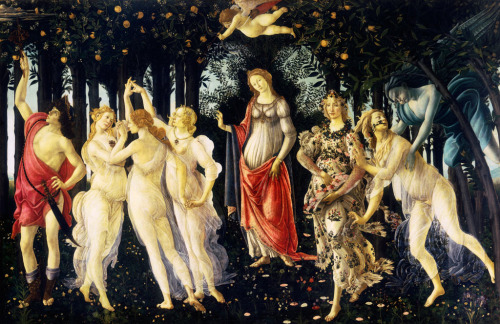
What is this image? |
|
Sandro Botticelli, Primavera, tempera on panel, ca. 1482
not made for the central branch of the medici family
distant cousin Lorenzo di Pierfrancesco de' Medici
made for a wedding, one of the events in which people would commission a great work of art made to celebrate
shows a complex subject, not totally sure what it means
on the right: see zephyr a winged god surprising chloris; raping her and this makes spring
see her turning into flora covered in flowers
flora is beside her
venus is in the middle, her garden, even though this is venus and the subject matter is classical, she doesn't look classic in proportions
see swaying curve, distended belly, invention of the classical past as something exotic, barely seems to tread on the ground, this is a courtly style
see the three graces who were made to embody the ideals of grace and lovliness, etc.
not classical, none are realistic really, the cloth moves in it's own accord, its calligraphy and lovliness and design and grace and abstract not classical
in its original context, was part of a piece of furniture, a bench with a high back, was on the back of the bench, was something you'd sit on and lean against
part of this couples bedroom furniture
not a classic but a part of people's lives
|
| |

What is this image? |
|
Sandro Botticelli, Birth of Venus, tempera on canvas, ca.
1485
has become more of a classic
compared to praxiteles, notice that she is not classical
can tell the story, she was born in the seas
her proportions and pose, not remotely classical, strange neck that is twisted to the side, sharp outline that defines the forms,
zephyrs blows her to the shore, hybrid figures representing the wind
more like a beautiful tapestry than an attempt at naturalism, the lack of naturalism is purposeful, shouldn't see this as a perfect beauty
see instead think about the courtly context and use the tradition we've studied to know that the artist was much like his time but radical
|
| |

What is this image? |
|
Giovanni Bellini, St. Francis in Ecstasy, oil (and possibly
tempera) on panel, ca. 1480
see an italian who is using northern oil paint
rich use of glazes
creates a lanscape full of thick darks and glittering lights, that is how the miracle is shown
st francis is praying in the wilderness, receives imprinted on his body the mark sof jesus from the crucifixition, nail marks
here he is suffused with light, the light through oil paint that conveys the miracle
|
| |

What is this image? |
|
Giovanni Bellini, San Zaccaria Altarpiece (Madonna
Enthroned with Saints), oil on panel, 1505
altar piece, painted for a church in venice
shows the madonna and child, saints and an angel
removed at one point during napoleonic times and cut down to make it a more normative rectangle, replaced to the church, thats why the botom and top slice are missing
with the trinity, perspective was realistically done
with this, our eye level is just about jesus' foot,
above an altar, the vanishing point there is about 10 ft in the air, significantly above our heads
here he messed up perspective on purpose in order to give us the sensation that we're floating,
notice the chapel is open on two sides to landscape, not realistic, no landscape in venice, usually walls on the chapel, venice is intensly urban
closer look: one of the ways we identify the saints is through objects they hold, as well as the colours they wear, peter in yellow and blue,
here he takes the yellow and blue, both a chromatic and tonal contrast, the blue runs into purples, yellow becomes orange, almost have complementary colours, complex vibration between the colours that creates a chromatic richness,
the saints look away from one another, lost in pockets of shadow
gives sense of interior meditation through the use of oil paint
|
| |

What is this image? |
|
Leonardo da Vinci, Last Supper, ca. 1495-1498
made for a monk's dining room
jesus at the moment of the last supper
painting is in a terrible state of repair, insisted on carrying out oil mural, didn't do it in fresco, the fluidity of oil, the painting was flaking off almost as soon as it was made,
if you look at a detail of Jesus' hand, can see that the tiny flakes were glued together
shows a biblical scene that was shown time and time again, one that had become a ceremony and instead changing it a living moment reserecting jesus in the sense that we feel the terrible moment
judas is amongst the apostles, takes us a minute to pick him out, we need to look and panic and see where the evil lurks
|
| |

What is this image? |
|
Ghirlandaio, Last Supper
tended to show the judas singled out, judas has no halo, that these are the saints to which you pray and that judas is not
the moment when jesus took the winde and said this is my blood, this is the moment usually shown
does seem to be the beginnings of the moment when one among you will betray me, can see some of the apostles gesturing, me?
|
| |
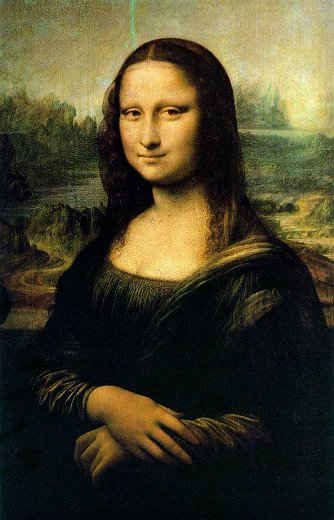
What is this image? |
|
Leonardo da Vinci, Mona Lisa, ca. 1503-1505, oil on
something strange and mysterious about this painting, why was it considered so exraordinary??
look at her body, its turned towards the side, on some sort of a balcony, looking out at some view, then turns to look at us, smiles slightly, she's reacting to our prescence,
debate about poetry vs painting, leonardo said that painting was better because you can fall in love with a painting of a woman but not a poem about a woman
here she is idealized, high forehead, non-existent eye brows, bridge of the nose the runs continuously from the forehead, made into an exquiste ideal, realization of pigmalean's dream, the perfect woman
detail of the hands: this pose has become conventional but leonardo was the one who created it
background: looks as if geological change is happening, don't see precise definition, not sure where the horizon line is, lost in a smokey haze, allows for a sense of motion, due to lack of contours, suggestion of the soul, what people said that they couldn't do
not an elitiest code, not some trick
art that makes a woman come alive so you can fall in love with her
|
| |

What is this image? |
|
Piero della Francesca, Battista Sforza and Federico da
Montefeltro, ca. 1472, oil and tempera on panel
portrait that is fairly standard for the 15th century, shows them in profile to make them look eternal and dignified, way of amking them emmorialized, battista was dead when this was painted, not the reason she was pale
the whole point was an eternal memory
|
| |
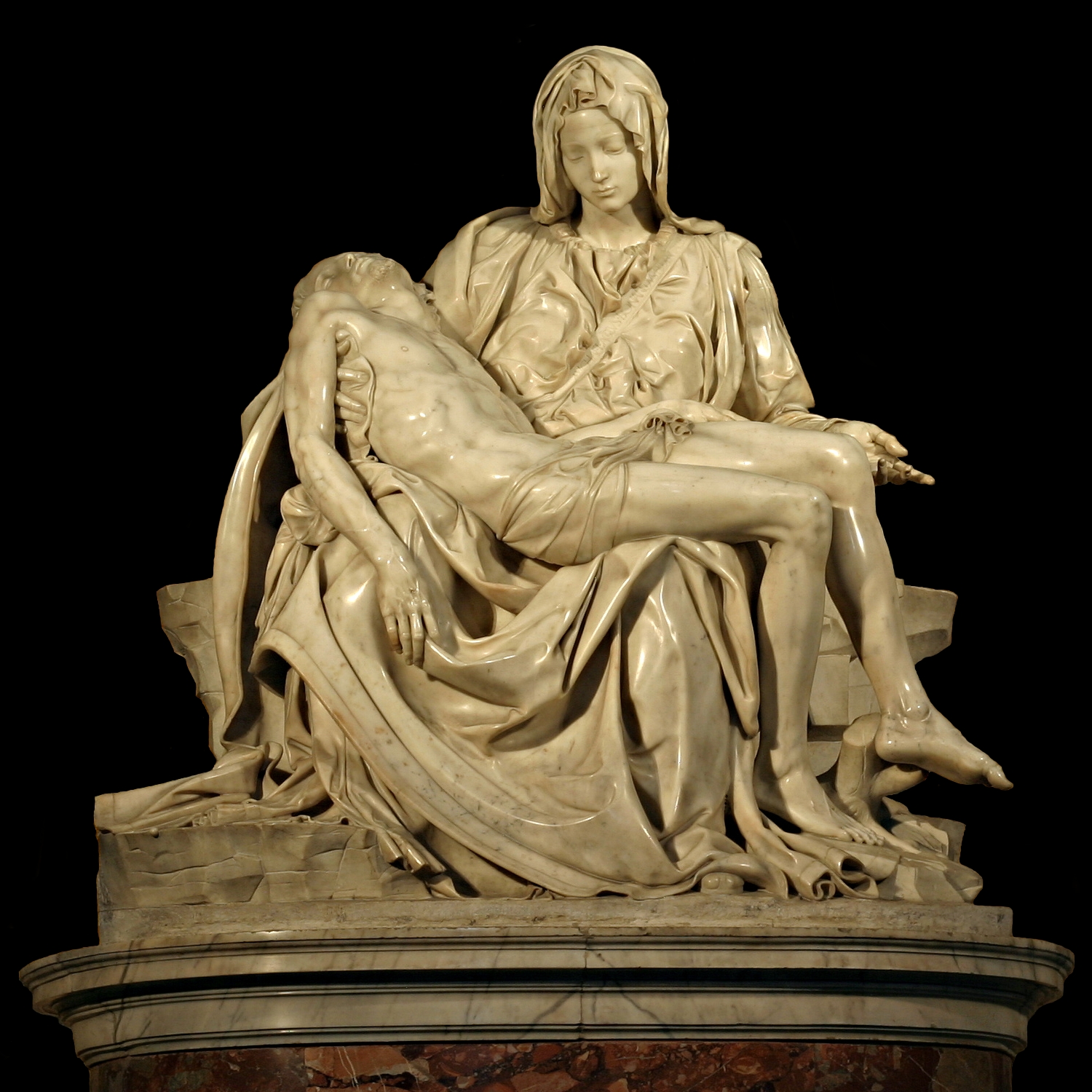
What is this image? |
|
Michelangelo, Pietà, ca. 1498, marble
was a follower and in many ways a competitor of leonardo
relatively early work
made this statue for a cardinal there, one of his earliest large scale commissions, michaelangelo exuisitely polished it, many of his later works were left unfinished
the moment in which mary holds her dead son in her lap after the crucifixition, why am I alive to hold my own son dead?, crushing moment of human dispair,
michaelangelo sculpts it
compared to the other pieta, gives us an equisitely gentle scene
seems too young here, she is both jesus' mother and she is the church so she is the bride of christ, she is shown here as young and lovely, her face is looking down gently
christ has no traces of torment, only the faintest indication of the gashes, almost as if we see a woman holding her lover in her arms and admiring how he looks when he sleeps, this kind of passionate metaphor is a sacred passion
here there is an equisite scene of love rather than one of pain
signature on the strap is signed by michaelangelo, gives us a sense of the pride in the work, kinds of strap that mothers would carry their baby with
can see that the statues is absolutely classical, the stylistic choice here matters, the renassance matters by using a classical style, michaelangelo has transformed the whole idea of teh pieta to a gentle story of love, in otherwords when you change the style, you change the conception of how we imagine ourselves and how we relate to God |
| |

What is this image? |
|
Michelangelo, David, 1501-4, marble, 13’5”
over life size
shows david, from david and goliath
mich shows us an earlier moment in the story, he's preparing for battle
muscles tensed, slingshot over shoulder,
unlike donatello's, which was something private and princely for the metichi
this was a public work made originially to go on an exterior butress of the florence cathedral
meant to be a counter weight on one of those butresses, made to be seen from a very large distance
which explains the rhetorical exaggerations
virtually no forehead, large hands, big feet
used rhetorical exagerration so that you see the hands hanging inactive but ready to attack, made the face larger, emphasized them so they can be read from a distance
he's actually departing from the story, david is a youth not a full grown man, can see that what was left in the story was less important to michelangelo
donatellos delicate figure is closer to the biblical story of david
the point was to express a heroic ideal, in specific the strength of the republic of florence
this statues was never placed bc this was a moment when the conception of art changed, had debate about where to put it, decided to put it in front of the town hall palazzo vecchio
as a political symbol of florence
have looked in the past that art was embedded into society bc the purpose and context is whats most important
was ripped from its inital place and purpose, basically said that art was more important than purpose; this was the change
his style is turning back to a much older style, rejects sophistication of donatello, turns back to look at nicola pissano for his model (Daniel), David is to nicola's daniel
David is now in a gallery, the galleria dell'Accademia; framed now as a pure work of art, all of the political resinances have been lost in this transfer
|
| |

What is this image? |
|
Sistine Chapel ceiling: patron, Pope Julius II, fresco,
1508-12
michaelangelo was asked to repaint the ceiling
said he wasn't a painter
unusual for a ceiling (his subject of painting) before this ceilings were blue with gold stars, so its new and strange and somewhat unexpected
this chapel is attached to the popes palace and performed many important functions to the catholic hierarchy, central to the whole idea of the power of the popes and therefore to the catholic church
comes as a suprise then that the ceiling is covered mainly with nude young men
seems to have evoked a kind of golden age, how the pope brought a new golden age, these figures are relaxed, time when acorns were a plenty and no one had to work for the food,
latitude for the mix of classical and christian, includes sensual moods in this important space, no one complained
paegean dream in the middle of christian rome
fall of man and expulsion from the garden; eat the fruit and become mortal, his paradise was simple, a couple of boulders, was not a painter of landscapes animals, except for what he considered to be the highest subjects, the heroic nude, was pleased when his paintings looked like sculpture, the snake instead becomes a human towards the top, couple of strange things, may have been taking a feminist view, shes a strong woman, not a temptress, adam is lunging over her head hoping to get an apple first, this is unlike any previous depiction of the scene, can see that it is very similar to massachio, has adam cowering away, eve covering her face showing its an intellectual shame; note that the sepent is a woman
|
| |
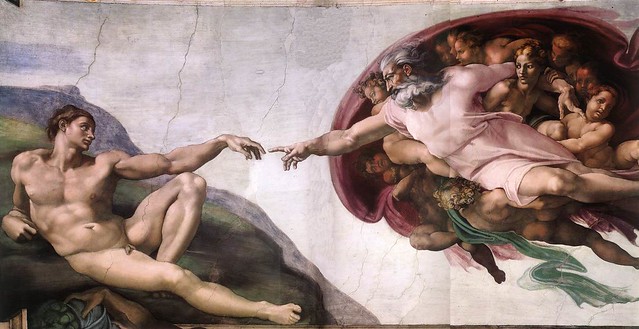
What is this image? |
|
Michelangelo, Creation of Adam, 1508-12, fresco
seems conventional now, but was extremely unconventional at the time, adam is curving almost a part of the form of the hill, God is imparting energy and life and giving this concave form with the bursting energy of God, the gap between them is eloquent and makes us feel the tension of the moment just before
God is imparting genious and life in a way thats not manual, inspiration rather than with physical technique, new image of God
generally wears a lot of drapery in the most royal coloures, jewels gold etc.
here he is wearing a pink shift, this colour is something you get naturally when you mix fibers together, not something that comes from expensive dyes, associated with poor laborers, includes this garment on God, through the physical strength of his torso that displays creative energy, God the father is purely immaterial usually but here he is fully physical so you can see all of his body, a radical move
michelangelo made God fly
|
| |

What is this image? |
|
Raphael, “School of Athens,” (Philosophy), 1508-1511,
fresco
working down the hall from michelangelo while he was working on the cistine chapel
had paintings of the wall to reflect the different books that were housed there
this one was the philosphy section
title which was created much later suggests something about the way it was made?
he creates a gigantic luminous space as if in eagar diologue, and puts plato and arostotle in the middle framed by light, plato points up, arostotle looks down and points down who thought about ethics on earth
euclid is doing a geometrical demonstration, not teaching normally, bent down really far, the students are lunging forward, big gestures, this is how raphael dramatized classical philospohy, seems something heroic?
included a portait of michelangelo last minute, in the foreground, the weeping philosopher heraclitus is shown as the sad figure turned away from all the others, turned away from the exctiting debate of all the others, so he paints michelangelo in michelangelo's style, powerful, etc. paying tribute to the great heroism of the painter, saying raphael can be graceful, but also can paint in the style of michelangelo
|
| |
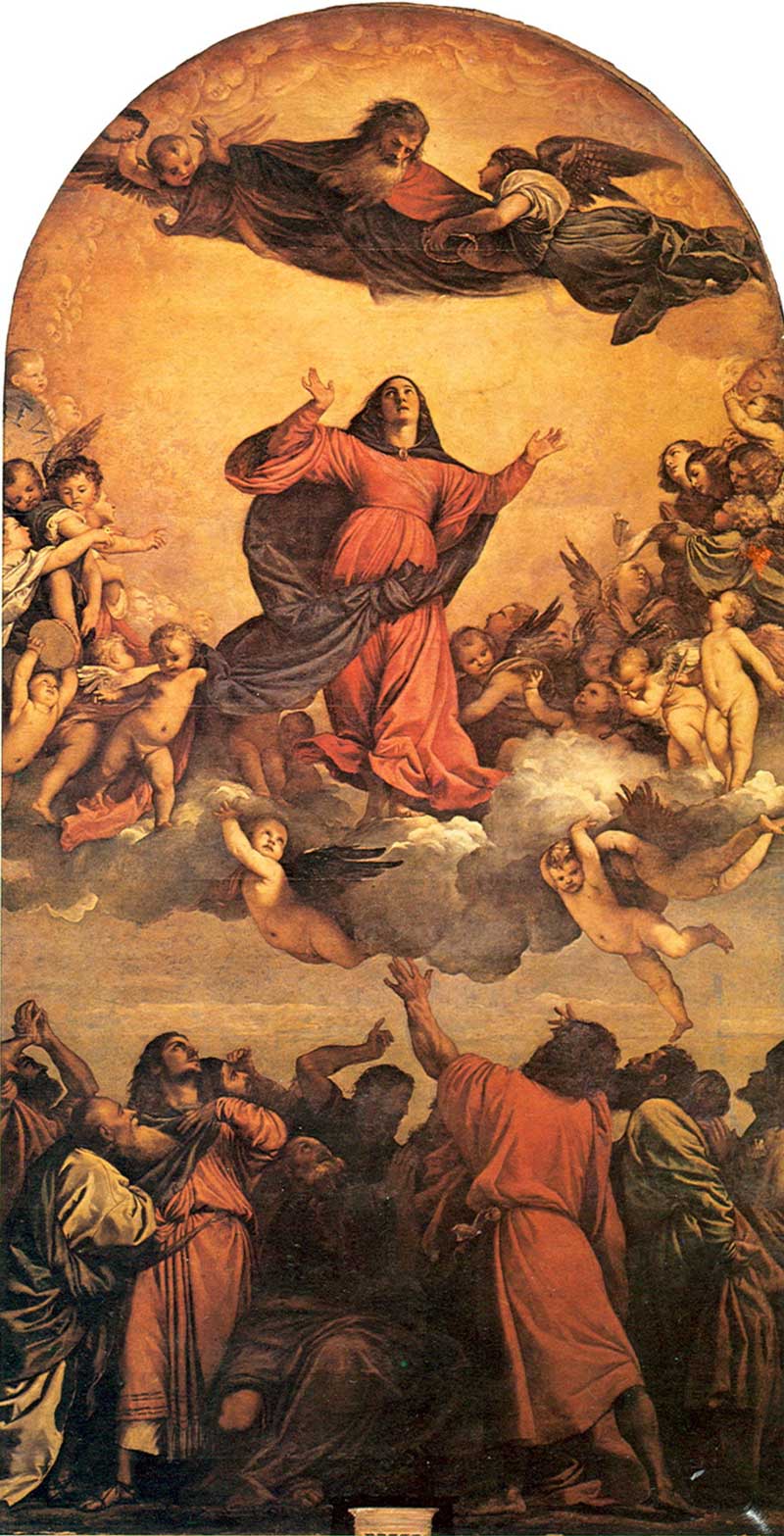
What is this image? |
|
Titian, Assumption of the Virgin, oil on panel, 1516-1518
in reaction and competition to michelangelo, hes a venetian artist, this is his first early work that shows subjects that haven't really been shown before, mary is ascending into heaven
this is a dramatic asccent with her arms spread wide is something new
the bottom half, see apostles gathed below, rather than seeing them as people with dignity, their figures lost in tabgled shadows, both a moment of triumph for mary, but pathos for humanity, christ has died and so had mary, the apostles are reaching up to her
see the virgin mary sailing upwards, seen as a heroine, both heavy and ascending, heaven is depicted as clouds which was a renaissance convention, previous depictions of heaven show it as an interior of the church, something architectural, something in human terms,, raphael and titian invented a new way of seeing heaven as clouds, as something you cannot measure, cannot touch, some mysterious realm that we can only begin to glimpse,
pudgy babies, noisy ascent, titian was responding to michelangeo in his depiction of God, says God is not some muscular feature we can understand, he is a face with forms you cannot define, does what michelangelo couldn't do, shows God as an undefined figure |
| |
|
